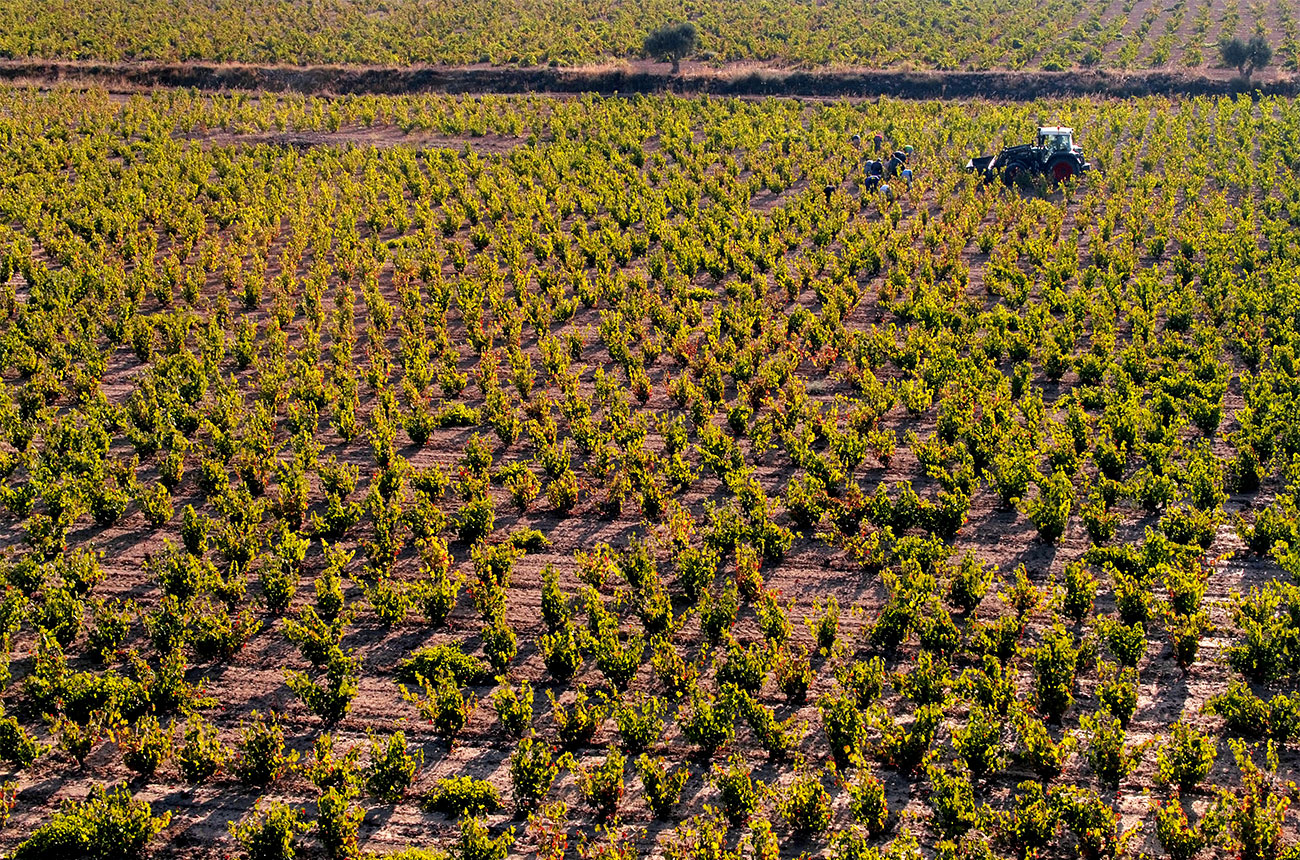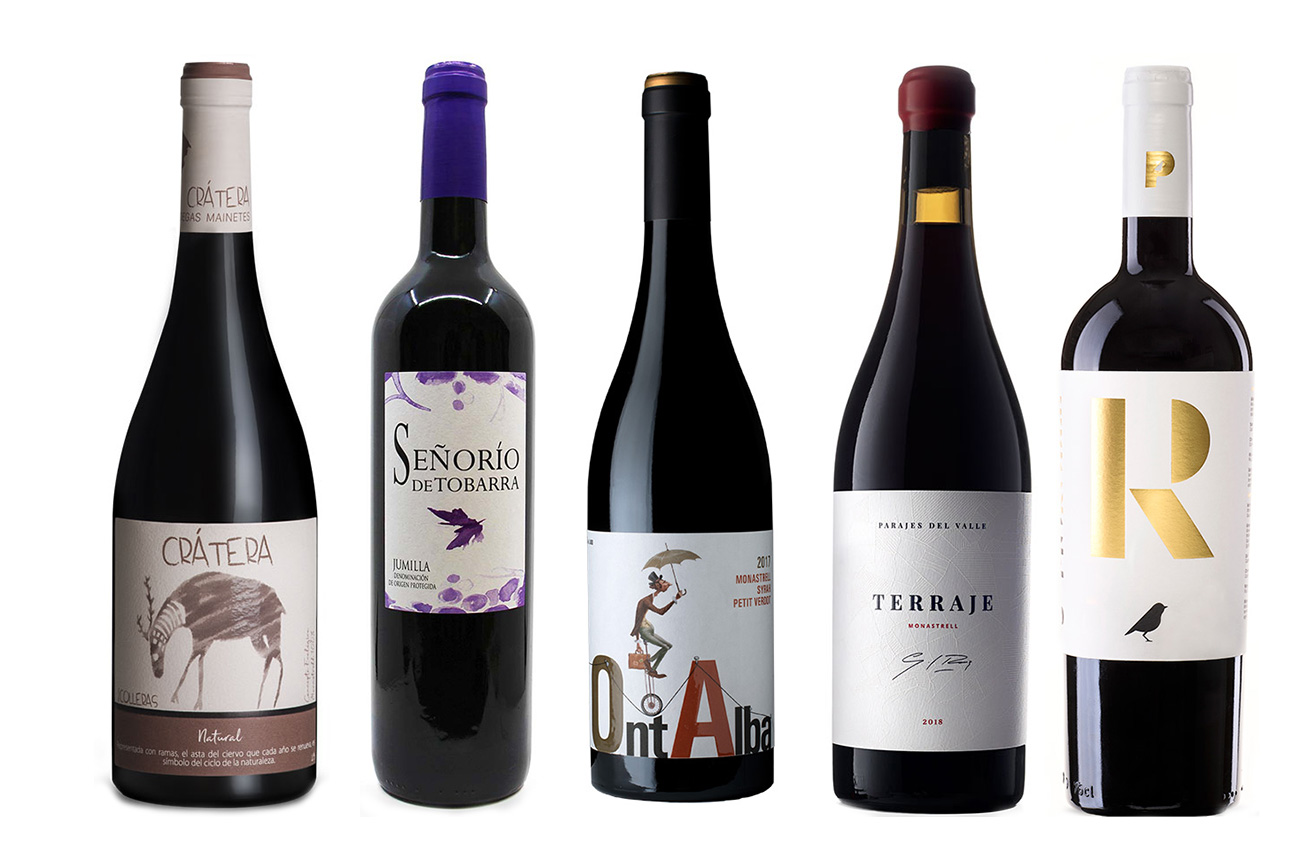Jumilla always made decent red wines. Decades ago Jumilla’s wines provided colour, fruit and body to boost blends produced in other more famous wine regions. The ambition of today’s generation of vignerons however is not so much to make decent, marketable products but to achieve wines of international acclaim.
Focusing on an indigenous grape, Monastrell, that is perfectly adapted to Jumilla’s sunny, dry climate and poor limestone soils, a growing number of passionate growers are confident that they’re on the right track.
Traditionally, grape-producers took advantage of the region’s generous sunshine by planting vines on south-facing slopes, thereby guaranteeing regular crops of fully ripe grapes. Today, the prime vineyard sites are on the region’s north-facing slopes, where the heat of the sun is gentler and terroir expression comes through in the wines.
This strategy is not risk-free, since Jumilla’s altitude and continental climatic influences make it prone to spring frosts and lower sugar levels in the grapes. Leading the way are a handful of talented, home-grown Jumilla producers who are achieving startling results.
New balance
At the forefront is José Maria Vicente, who single-handedly runs the vineyards and cellars of his 170ha Casa Castillo estate, 12km from Jumilla. Planted in the shade of the Sierra de Molar his Monastrell and Garnacha reveal floral aromas and notes of mountain herbs and lavender. Following his lead, two young brothers at Fuente Alamo in Albacete province are also producing wines with totally different balances from the old norm. Carlos and Juan José Cerdan make stunning terroir-driven wines with floral expression and high acidity. While Vicente cross-references Casa Castillo with Châteauneuf-du-Pape, Carlos compares his top-end La Calera de Escaramujo to Barolo.
Jumilla’s dynamic promotional body at the Consejo Regulador has recently been focusing its communication on the natural balance found in Monastrell. Interestingly, by virtue of the compact nature of Monastrell’s bunches, in which the outer berries ripen quicker than those in the centre, a certain balance is achieved within the whole bunch.
Could this be why many Jumilla reds can appear very ripe on the nose and yet relatively dry on the palate? On smelling the wine, your brain prepares you for something rich and exuberant in mouth. Instead, the palate is often more restrained with a pleasant tannic structure and dry mineral finish.
Some of the most balanced, elegant Jumilla reds are produced by the Viña Elena winery, which is located in the southernmost part of the appellation, where the cool Continental climatic influences are countered by warmer Mediterranean currents. This is evoked in the word ‘bruma’ (mist) which is the name of Viña Elena’s flagship range.
Winemaker Elena Pacheco looks to bring out the more delicate red berry fruit character of the Monastrell, in balance with fresh acidity and length of flavour. The Bruma Marin 2019 is an excellent example, while the more upmarket Bruma Particiones is more dense and fleshy but still maintains elegance and balance. For sheer hedonistic enjoyment, the winery also makes a delicious straight Syrah.

Terroir driven
Juan Miguel Benitez, the winemaker at Jumilla’s oldest winery, Alceño, in the heart of Jumilla town, is another keen proponent of planting on north-facing slopes. Not only Monastrell, but also Garnacha Tintorera (at high altitude on gravel and limestone soils) and Syrah in Jumilla’s volcanic south-western zone. His exciting new release, Laderas del Volcan (a blend of Monastrell and Syrah grapes sourced from volcanic slopes) offers a mesmerising mix of raspberry aromas mingling with mineral notes.
Slightly more market-driven wines are produced at Bodegas Carchelo, just outside Jumilla town. Again, the cool terroir provided by the shade of the nearby Sierra de Carche is central to its winemaking philosophy.
Wine lovers with only a passing acquaintance with Jumilla wines may be familiar with the name Juan Gil, Jumilla’s emblematic and highly successful family-run winery. Producing an impressive range of great value for money wines, Juan Gil has access to some of the finest raw material across the appellation. The exuberant, rich, heady style of its internationally famous premium wines is well-known, but entry-level labels, such as Honoro Vera Monastrell, are beautifully balanced and offer amazing value.
Of similar great value are the wines of Silvano Garcia. Partnered by French winemaker Valérie Durand from Narbonne, Garcia has recently built new facilities outside Jumilla town. While his premium brand Etiqueta Negra is a local favourite, his Viñahonda 2019 is an attractive, complete wine displaying less oak and huge Monastrell charm.
Working together
As Jumilla’s finest terroirs are still in the process of being discovered, and investors have been slow to snap up premium sites, many of Jumilla’s growers with vines planted in excellent limestone terroir continue to sell their grapes to cooperatives. The BSI co-op (Bodegas San Isidro) close to Jumilla town is able to source a whole range of lots, some of them of impressive quality, which they maintain separately in order to showcase different Jumilla styles.
One such fine example is the Gemina ungrafted Monastrell brand, a classic, well-balanced Monastrell with red berry fruit and minerality. Similarly, in Fuente Alamo in Albacete province, the San Dionisio co-op has access to great raw material. Its barrel-aged Mainetes is a more Mediterranean expression of this part of Jumilla with sweet red berry fruit and vanilla notes.
At Pio del Ramo in Albacete province, whose owner is the charismatic Pio del Ramo Nuñez, suitably characterful wines are produced, such as Pio Roble, a lightly oaked entry-level brand that shows a lively tannic structure to complement the fruit aromatics.
Clearly, Jumilla has the soils, landscape, climate and grape varieties to make superb red wines. As can be seen, the viticultural strategies are key. But just as important are the winemaking choices. However balanced the raw material may be when it arrives in the cellars, the ageing process is crucial, since Jumilla reds aged in barriques appear to take on rather too much oak, whereas judicious ageing in larger formats such as foudres or in concrete maintain and enhance those precious balances. A lesson that Jumilla’s rising stars appear to have taken on board.
Jumilla reds to try

Alceño Roble 2019
Monastrell
Lots of charm with cherry fruit and a touch of vanilla sweetness. Nicely structured and harmonious.
UK: Vindependents www.vindependents.co.uk
USA: Vinedos Selection vinedosusa.com
Asensio Carcelén 100×100 Monastrell Ecologico 2019
Monastrell (organic)
Ripe forest fruit with hints of Christmas pudding. Smooth and sweet in style rather than fresh. Structure and some complexity.
UK: Bodega Soul bodegasoul.co.uk
USA: not available
BSI (Bodegas San Isidro) Gemina Cuvee Seleccion 2016
Monastrell (ungrafted vines)
A complex nose of smoky black fruits, hints of Christmas pudding and dark chocolate. A hint of over-ripeness of the palate but this is balanced by minerality and a pleasant dry finish.
UK: Ehrmanns www.ehrmannswines.co.uk
USA: not available
Bleda Castillo de Jumilla 2019
Monastrell-Tempranillo
Nice elegance and balance with good tannic structure.
UK: not available
USA: Tricana Imports www.tricanawines.com
Casa Castillo Las Gravas 2018
Monastrell (ungrafted vines)
Elegance and complexity with subtle red and black fruit aromatics. Fine and air-light in mouth. A beautifully balanced wine.
UK: Indigo Wines www.indigowine.com
USA: European Cellars www.europeancellars.com
Mainetes Cratera Parcela Colleras
Monastrell (organic)
Fine red berry fruit and well-integrated creamy oak. Soft tannins and quite elegant on the palate.
UK: not available
USA: not available
Winery website: www.enoturismomainetes.com
Nuestra Señora de la Encarnacion, Señorio de Tobarra Tinto 2019
Monastrell
Terrific value for money. Clean, cherry-fruit nose with hints of liquorice and spice. Supple and balanced on the palate.
UK: not available
USA: not available
Winery website: www.bodegaencarnacion.es
Ontalba Equilibrista 2019
Monastrell-Syrah-Petit Verdot
A complex spicy wine with ripe fruit. Good balance on the palate.
UK: García Grapes (no website)
USA: Wines & Beyond (no website)
Parajes del Valle, Terraje 2018
Monastrell
A sweet creamy strawberry nose that develops in the glass with mineral, toasty notes coming through. Juicy fruit on the palate and soft tannins balanced by a pleasant dry finish.
UK: not available
USA: not available
Winery website: parajesdelvalle.es
Pio del Ramo Pio Roble 2017
Monastrell-Syrah-Cabernet Sauvignon (organic)
A seductive nose of ripe fruit and integrated toasty oak. A serious wine on the palate with some tannic austerity.
UK: not available
USA: Espana Wines espanawines.com

Ramon Izquierdo 2019
Monastrell (organic)
Very ripe, dense, full wine. Easy-drinking.
UK: not available
USA: not available
Winery website: www.ramonizquierdovinos.com
San Dionosio Mainetes Crianza 2017
Monastrell
Sweet, red berry fruit and vanilla balanced by nice acidity. Integrated oak and notes of tobacco.
UK: not available
USA: Kysela Pere et Fils www.kysela.com
Sierra Norte Equilibrio 9 2017
Monastrell
An approachable, well-made wine with good structure, toasty fruit and some complexity.
UK: not available
USA: Tradewinds www.tradewindsspecialty.com, Verity Wines veritywines.com
Viña Elena Bruma Paraje de Marin 2019
Monastrell
Very attractive nose of red berry fruit, minerals and spices. Precise, just ripe with complexity on the palate.
UK: Alliance Wine www.alliancewine.com
USA: The Spanish Acquisition (New York & New Jersey) www.spanishacquisition.com,Wines Unlimited (Louisiana) www.winesunlimited.com, Matinicus Wines (Colorado) www.matinicuswines.com, ¿Por qué no? Selections (California) porquenoselections.com
Xenysel Pie Franco 2020
Monastrell (ungrafted vines)
Needed some air. Fine red berry fruit coming through. Quite delicate with ripe tannins and a long finish.
UK: Jeroboams jeroboamstrade.co.uk
USA: Codipral codipralus.com, Vinaio www.vinaioimports.com, Trovato www.trovatowine.com







